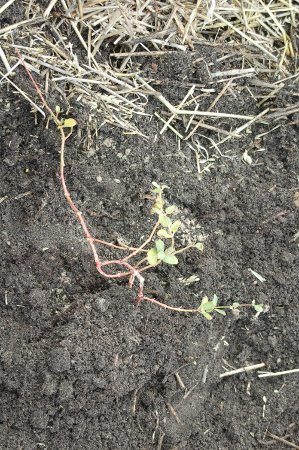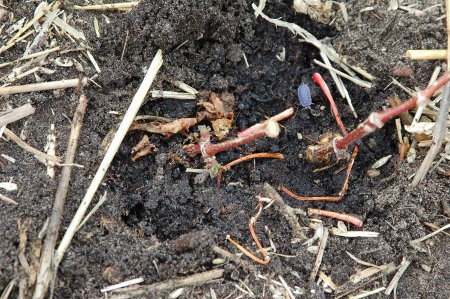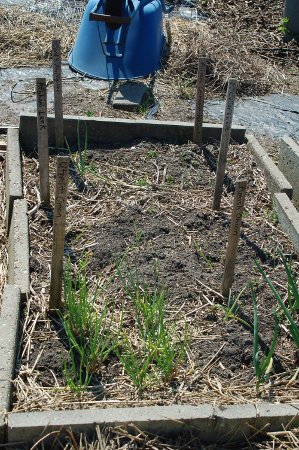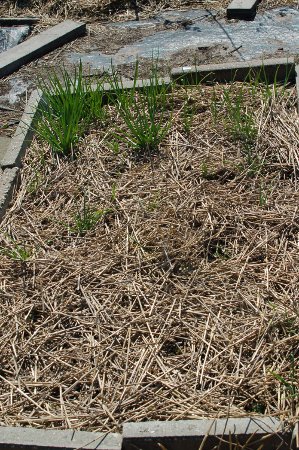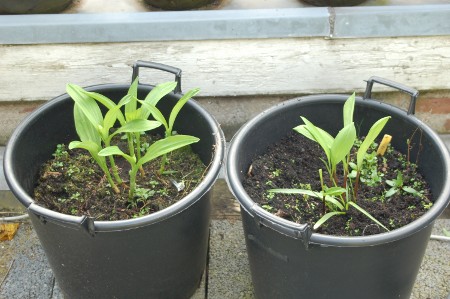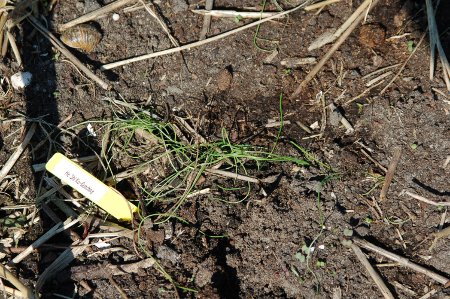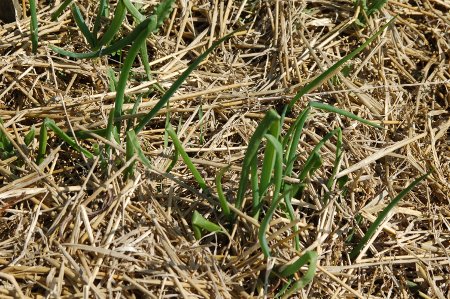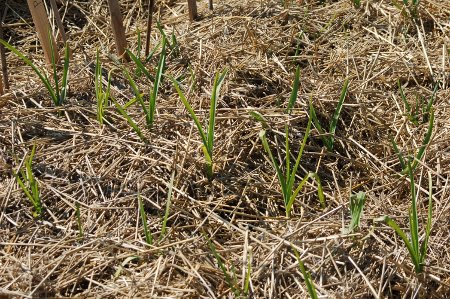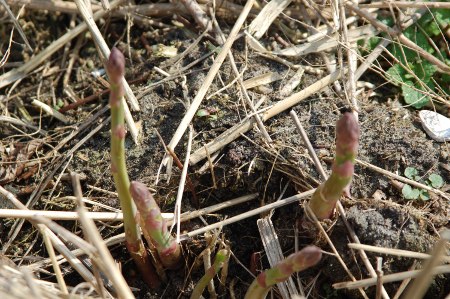
We’re finally getting our first asparagus spears! Steph and I had the very first one the other night; lovingly cut into 6 pieces, gently sauteed and savored one piece at a time. It was very tasty.
Many more spears are on the way, and since this is the third year after starting from seeds, we are allowed to harvest lightly. I made earlier posts about year 1 and also here, as well as year 2 here.
I’ve really learned a lot starting asparagus from seeds, and in particular it’s something I would really recommend others do. It’s really taught me that most of the preconceptions about growing asparagus are wrong, and I think I’ve probably ended up with much stronger and better plants than if I followed the usual advice or started with purchased crowns.
In particular, most of the advice commonly given with purchasing and growing asparagus crowns emphasizes what you need to buy; soil amendments, fertilizers, digging deep trenches, and so on. As a matter of principle, I don’t feel it’s necessary to buy these kinds of things or disturb your soil in this way, in order to grow nice things to eat. Asparagus is no exception.
It’s true, growing from seeds it will take an extra year before your plants are mature enough to eat. But really, does this matter? Established asparagus crowns will last 10 years or more, and presumably you will have your garden for some years anyway. Is it really necessary to pay the extra money and spend the extra time with commercial asparagus crowns, just so you don’t have to buy your asparagus at the market for an extra year?
In addition, if you have a neighbor or friend with an established asparagus bed, you may be able to get a crown from them, for dividing and planting in your own garden. I’ll explain this more below.
If you have genuine problems with your soil or garden, these need to be addressed, and asparagus is a heavy feeder with deep roots which is also something you need to keep in mind. Otherwise asparagus doesn’t need any special care.
Think about all the CO2 invested in the average gardener’s asparagus bed.
As much as anything, by requiring all this special care in planting, the companies who sell the asparagus crowns can point the finger at you if they don’t grow well. The reality is it comes down more to genetics than how you plant it, and I’m going to explain here how you can find the best asparagus plants with the best genetics for your garden, growing from seeds.
If you haven’t had luck with growing asparagus in the past, I would urge you to give it another try.
The Seeds
Asparagus seeds are notoriously finicky, and the plants that result from OP varieties are highly variable. The variability is a good thing! The finicky nature of them is not necessarily so good.
It’s also been my experience that seed companies tend to give you a very small number of seeds in each package, usually 20 or so. This is great if they all turn into perfect asparagus plants, but don’t count on it.
Germination is often a problem. I have had very low germination rates over the years. Gintoino for example sent me seeds two years in a row from his garden, and I couldn’t get them to germinate. Also about half the purchased packages of seeds I’ve had didn’t germinate.
My advice is to try to get seeds from at least a few different sources, both to increase your chances of getting some seeds that germinate as well as to make sure you have enough plants to get a good start, be able to select stronger ones and discard weaker ones.
It all depends on your garden space and budget, but in an ideal world I think ending up with about 100 plants and being able to make an initial selection the first year of about 50, then select 20 the second year, would be about perfect.
Note, the above advice on the number of plants assumes you are growing an OP variety. If you purchase F1 seeds, they will be less variable, and you will need fewer plants. This also means you will have less opportunity to select the best plants genetically for your own garden, and will make seed saving more difficult.
The first year the plants are small and don’t take up a lot of space. You can probably use a spacing of about 4″ (10cm), with rows about 1 ft (30cm) apart.
In my case I think I ended up with about 20 seedlings the first year, and didn’t make any selections, and I still had good results (at least so far).
I have recently read that soaking the seeds for 48 hours in water will help germination rates, so I would suggest doing this.
In my case I started my seeds indoors a few months before the last frost in my area, but I’ve also read that direct seeding works well too.
The Selection
You simply want the best plants. Look for the ones growing the fastest and healthiest looking.
The Second Year
After your plants have grown for a year, they will have developed crowns in the ground.
There was a little discussion on the Internet recently that you could probably find with a little Googling, about if it’s best to transplant asparagus crowns in the fall or spring.
Apparently, historically this has always been done in the fall after the tops of the plants die back. In modern times we tend to plant asparagus in the spring, because that’s how the commercial cycle of selling crowns works. The growers harvest them in the fall, and they are distributed over the course of winter for spring planting.
While I think either spring or fall planting should work fine, in general I would suggest doing it in the fall.
Simply dig up the crowns you have grown, and select the best of them for transplant into your second year asparagus bed. As you dig them up, note how vigorous the tops have grown, as well as the overall appearance of the crown. Of course if you damage any while digging them, be sure to discard these.
For eating purposes, the male plants produce the best spears. Therefore if your goal is to only have plants for eating, at this point you should discard any plants with berries on them. You can see a picture of these berries in this post here, which turn red after ripening. If you want to use the plants for producing more seeds, be sure to keep one or more female plants.
These crowns should be planted as soon as possible, preferably right after digging, into your second year bed. This won’t be your final bed, but it will produce harvestable asparagus and you will probably want to keep it for a few years. After harvesting, asparagus plants become rather large and cumbersome, and not very attractive. You may want to consider this when choosing the location. If you are very short on space, you can dig up this bed at the end of the season for replanting the divided crowns, but this will delay your first harvest for an additional year.
The number of crowns at this point is up to you, but 10-20 is a reasonable number. In my case I hadn’t done any initial selection the first year like I mentioned above, had 20 plants, but only 10 of them survived the first season. So in my case, I had 10 crowns for replanting. You should plant the crowns at least 1 ft (30cm) apart, in rows about 18″ (50cm) apart, but if you can give them a little more space that would be better. The ground should be prepared in an appropriate way for plants with deep roots that are heavy feeders. Consider inter-cropping something nitrogen fixing, like beans or white clover. Be sure to add generous amounts of home made compost. In my case I planted them in a raised bed that was filled with several inches of compost. Be sure to keep the weeds under control.
There is some debate about the virtues of planting asparagus crowns deeply, in a trench, then filling in the dirt as they grow. The basic problem is asparagus crowns tend to rise to the surface, and do benefit by being covered. I think however trying to plant them deeply is not a very effective way of addressing this problem, because after a few years they will rise to the surface of your garden anyway. It’s also very possible to kill the crown by planting it too deeply. In general, I suggest replanting the crowns at about the same depth they were when you dug them up. I don’t think it’s necessary to make special trenches for them.
After growing them the second year, they should really start looking like asparagus plants! You should start to see some spears that look edible, but be sure to resist the temptation of eating them yet, because the plants need all of their own resources for developing strong crowns.
Dividing the Crowns
After 2 long years of waiting, you are finally ready to choose 1 or more crowns to make up the genetic base of your asparagus bed. For eating purposes, the male plants are best. Otherwise, look for the best growing crowns, and dig them up. In my case I choose one crown and divided it into 10 pieces, which is about the maximum. These will be planted in your final asparagus bed, so consider the location carefully.
You will notice, as the asparagus grows, it will send up multiple shoots, like the picture at the top of this post. Each one of these shoots is connected to a part of the crown that can be divided off to grow by itself. When you divide the crown, all of the individual pieces will be genetically identical clones. If you will be saving seeds later from your plants, try not to narrow your genepool too much by not choosing enough crowns initially to make clones from.
Digging up the crown and dividing it at this stage takes considerable effort. It’s roots are pretty deep, and tightly entwined. Do your best not to damage it in the process.
After dividing my crown last year, here is a picture of one of the shoots emerging:
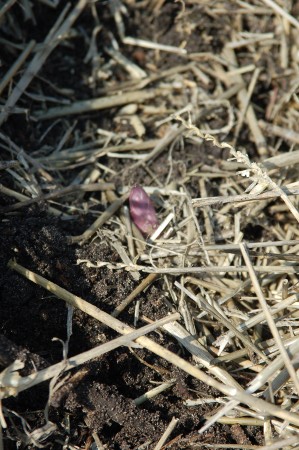
Notice, because it’s not a complete crown, just a piece of one, there’s only one shoot. As with all recently transplanted crowns, you should not harvest the first year and only harvest lightly the second year. So these crowns, in my final asparagus bed will come a year later. I will however be able to keep using my second year asparagus bed for harvesting until the time this bed is ready.
Notice this shoot is bigger than the shoots in the picture above. This is because I choose the best crown for dividing, and so in the end I should get the best asparagus from it.
Like I said above, I made 10 divisions from the crown last year. Not all of them appear to have survived. At the moment, 5 have sent up shoots. I will probably need to repeat the process of dividing and replanting the crowns for a few years before I have a full bed of asparagus plants.


